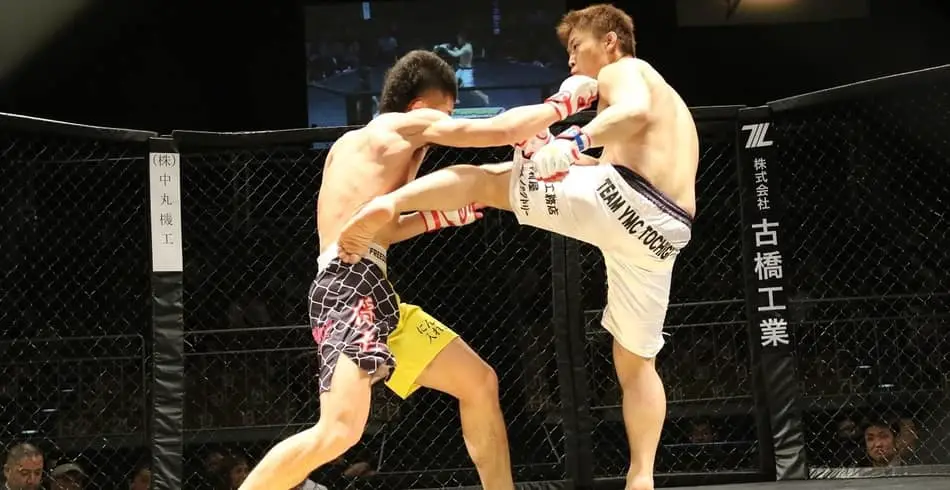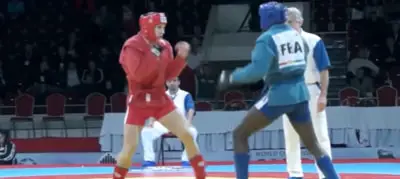
Sparring is one of the most important things you need to do to improve your skills in any combat sport. But there are some differences between sparring in MMA and in other striking or grappling martial arts. In this article, we’re going to discuss the specifics of MMA sparring, how often, and how hard you should do it.
How often should you spar in MMA? That depends on your level. If you’re a still beginner but you have some skills (5-6 months of training) you should spar 4 times a month. That way you’ll get used to the grind which is super important whether if you train MMA to compete or for self-defense. As you become more and more experienced, you should spar hard less and less and eventually do it 1 time a month or even less often.
Hard sparring will help you get comfortable with getting hit and you’ll learn how to defend all different kinds of attacks – boxing combos, kicks, spinning attacks. Once you saw it all, you’ll become much better defensively and more confident on the feet.
After that initial period, doing regular hard sparring won’t be beneficial anymore. It can actually hurt you because you can get injured or concussed. You can then do hard sparring only 1 a month or even less often. Doing drills and super technical (lights) sparring will be much more beneficial at that point.
The hard sparring at the beginning of the fights if you’re a professional already made you tough enough, you won’t get much tougher, most likely you’ll get just more damaged. Now the focus is more on improving your technique and strategy and doing hard sparring occasionally whenever you feel you need them.
At the higher levels, there’s no correct answer on how often you should spar. It’s more how you feel it. If you feel like you don’t need to spar don’t do it. There are super high-level MMA fighters and former UFC champions like Robbie Lawler and Tony Ferguson who don’t spar at all for years. The best athletes are very good at listening to their body so you should do that too.
Old school fighters believe that iron sharpens iron so they go hard at each other regularly. But nowadays people know much more about the injuries you can get from damaging the body in starring with the most dangerous one being the CTE.
That’s why the new generation of fighters spar less often and even when they spar they don’t spar hard but use the sparring to work on their game plan and to test their cardio.
In the rest of the article I’ll talk about the different types of sparring in MMA and how often you should do them.
MMA Sparring
There are two different types of MMA sparring – with big and small gloves. When sparring with big gloves (usually 16 oz) you can put more power in your punches but it’s hard to grapple. This is the type of sparring MMA fighters do more often, sometimes every week.
And when sparring with small 4 oz MMA gloves the grappling it’s much easier because your fingers are free and you have a better grip but you can’t punch your sparring partners hard because of the little padding.
MMA fighters spar occasionally (once a month for example) with small gloves to work on their MMA grappling or to feel the striking with small gloves. When sparring with 4 oz gloves, fighters just touch each other, they don’t put any power in their punches.
Others for example the Bellator fighter Matt Mitrione throws punches with 100% but pulls them back before hitting the target. That requires some practice but isn’t that hard to do.
MMA isn’t a martial art on its own. It’s a combination of all kinds of different martial arts – boxing, kickboxing, Muay Thai, BJJ, wrestling, etc. MMA fighters don’t always spar under MMA rules. They often practice just one of the martial arts I listed above.
That way they can focus and improve only their boxing, kicking, grappling, or wrestling. Fighters who prefer to strike, do a lot of kickboxing sparring. Others who like to wrestle/grapple often just grapple, work on their ground and pound or submission attacks.
Kickboxing Sparring
At the beginning of the article, when I talked about hard sparring I meant full contact kickboxing sparring with close to 100% power. When people put on their 16 oz gloves, shinguards, and occasionally headgear and start throwing hard.
This is one of the most beneficial types of sparring you can do to prepare you for a fight but it also can cause the most micro concussions because of the different types of strikes – punches, kicks, and even knees.
Most kickboxing/MMA gyms have a full sparring day (usually Friday) when they go hard. In the rest of the days, there’s still sparring but it’s mostly drills and a little technical sparring.
If you’re a beginner it’s good to spar every Friday or whenever the sparring day is. There are some things to consider though. There are unwritten rules about kickboxing/Muay Thai sparring.
For example, things such as knees and elbows to the head, front kicks to the face, hard knees to the body, pull power spinning techniques aren’t cool moves. Usually when somebody throws some of those techniques that start a gym war – sparring with 100% power. So be careful when using those are when someday use them on you – he probably doesn’t have the best intentions.
Another thing to consider is your level compared to the level of your opponent. If there’s a big difference, the sparring shouldn’t be hard. There’s no point in beating up someone much less experienced than you. The same goes for sparring with a fighter on a much higher level than you.
If he is super aggressive and throws too hard you can ask them to go a little lighter with you and if they don’t do that, just refuse to spar with them. It sucks when that happens but obviously they aren’t going to protect you while sparring, you have to protect yourself.
Now, at some point, usually, after a few months of training, you should definitely spar hard to feel an intensity close to a real fight. And after a few of those hard sparring sessions, you’ll actually don’t need them as much in my opinion.
On the other hand sparring is fun and some people enjoy doing it regularly. I agree with that but that’s only when it’s light/moderate with someone on your level or below your level or with a much better fighter who is friendly and tries to have fun and help you improve your skills while sparring.
Boxing Sparring
Because of the lack of kicks boxers spar much more often. In boxing, there’s no chance to hurt your foot or your knee while kicking which are the most common injuries in kickboxing sparring.
Most boxers spar twice a week but in many gyms, there’s a full sparring day like in kickboxing. So one of the sparring days is a little more technical sparring while on the other day – hard sparring.
The problem with boxing sparring is that 80% of the strikes are to the head so micro concussions occur a lot. So my tip for boxing sparring is to do it with 80% power to the body and 50% to the head to avoid brain damage.
Muay Thai Sparring
Muay Thai fighters sparring spar often. Their sparring is actually quite fun. They don’t go hard since they often spar without using shinguards (at least in the past).
Their sparring is playful and they throw a lot of teeps to the body, leg kicks, and engage in clinching. They usually don’t throw elbows at each other and even when they do, they stop the elbow before hitting the sparring partner.
Sweeps happen often in Muay Thai sparring. Although Thai fighters don’t spar hard, they sweep each other. There are hard and light sweeps where you either just disbalance the person or you use more power and make him fall on his butt. Before using sweeps in sparring, ask your sparring partner if that’s ok.
When Muay Thai fighters want to spar hard, they use shinguards and sometimes elbow pads. They don’t throw punches with 100% or they throw them hard and pull back the shot before hitting the target. That’s not the case with kicks though. Kicks are harder to pull back. You either throw a fast and powerful kick or slow and weak kick. They are kicking each other pretty hard so make sure your blocks are on point.
BJJ Sparring
Grappling sparring can nothing to do with striking sparring. You can grapple without hurting each other, especially when practicing BJJ. BJJ is a gentle sport and almost everybody can do it no matter how old or small you are.
In BJJ it’s not called sparring but rolling. And they roll after each practice. There is however a difference between light, and hard, more intense rolling. When rolling light, also referred to as “flow rolling”, you are more focused on technique and tricking the opponent rather than on out-hustling him.
You often don’t resist reversals and scrambles but you go with the flow, hence the name. That’s a pretty cool type of rolling which lets you work on technique and strategy while having fun.
But the hard rolling can be fun too. There you apply much more resistance and pressure and often you “smash” the opponent or you’re getting smashed. By smashing I mean applying pressure from the top position. That can suck at first but it’s actually very beneficial for beginners because it teaches them how to regain their guard, how to hip escape, or to scramble to stop that pressure.
So both types of BJJ rolling are super fun and great to do at any level. Unlike striking sparring, BJJ sparring doesn’t hurt and can’t give you a concussion. There are other injuries you can get through, for example, knee, neck, or finger/toes injuries which will discuss in a minute in more detail.
Although BJJ sparring is not dangerous like kickboxing/boxing sparring, some things are considered dick moves. For example when applying unnecessary pressure with your knees or elbows to your sparring partner’s throat, groin, hips or ribs, etc.
You can do some of those techniques, for example you can apply pressure to the hip of your partner to make him open his guard when you’re trying to pass it. But that’s not unnecessary because you have a goal in mind. Unnesseccary pressure is when doing it just to hurt your opponent.
Another dangerous thing to do while rolling is the legs locks and more particularly the heel hooks. The heel hook is a submission that applies pressure on your knee ligaments which can get tear pretty easily and quickly. Only experienced BJJ practitioners should do them.
That’s why heel hooks and other leg locks like toe-holds, ankle locks and kneebars aren’t allowed up to purple belt in tournaments and in most gyms in practice.
Wrestling Sparring
Wrestling is a super competitive sport so wrestlers spar hard very often.
Although MMA fighters don’t spar under wrestling rules, they often start grappling on their feet. An important thing to consider while working on your wrestling for MMA is that it’s super exhausting. I gassed out completely after just 2 rounds of wrestling when I tried it for the first time.
So make sure you don’t spend your energy too quickly.
Most Common Sparring Injuries
Concussions are the most dangerous thing you can get from sparring in the long run because they can cause CTE if you spar hard regularly. But concussions aren’t particularly going to slow down your progress – which is the most important thing for many MMA fighters and enthusiasts.
Things like bruised ribs occur often especially during kickboxing and because of the pain they can prevent you from sparring and even punching effectively for more than a month.
Other similar injuries are broken/swollen feet – most of the time due to a kick in the elbow or the knee of your sparring partner. During striking sparring you can also get a broken nose, chipped teeth, dislocated jaw, or damaged knees due to colliding with someone else’s knee.
Such injuries can make you unable to train for months. That’s why you should never go 100% in sparring. Put 50% in your shots to the head and 60-70% max to the body.
Those are the injuries you can get from kickboxing/boxing sparring. When it comes to grappling you can also get teared/damaged knee ligaments, elbow, neck, shoulder, finger/toes, and other injuries. Mostly joint injuries but things like bruised ribs can happen too if you roll with someone much bigger and even concussions if you fall on your head.



